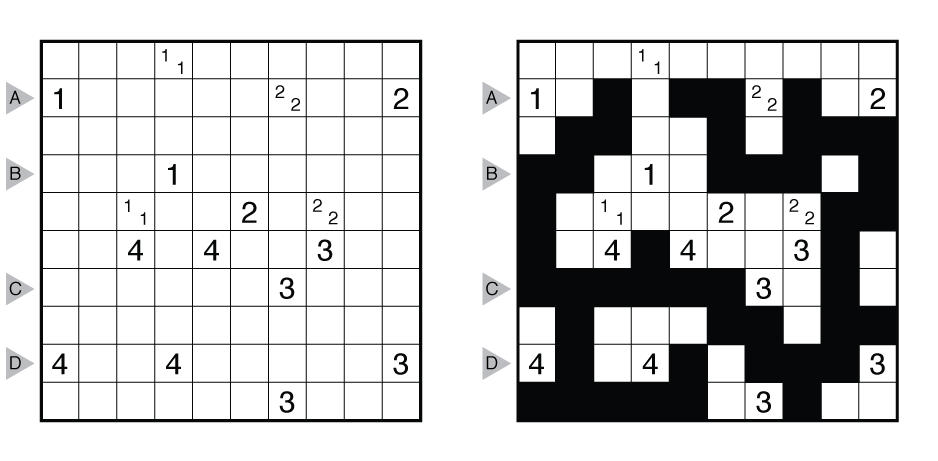Tapa Rules and Info

Rules: Shade some empty cells black to create a single connected wall. Numbers in a cell indicate the length of consecutive shaded blocks in the neighboring cells. If there is more than one number in a cell, then there must be at least one white (unshaded) cell between the black cell groups. Cells with numbers cannot be shaded, and the shaded cells cannot form a 2×2 square anywhere in the grid.
Answer String: Enter the length in cells of each of the shaded segments from left to right for the marked rows, starting at the top. Separate each row’s entry with a comma. This example has the key “121,231,61,113”.
(Brief) History of Tapa: Tapa was created by Turkish puzzle designer Serkan Yürekli in 2007 for the Internet Puzzle Solvers Test (IPST) and was first regularly published by Akil Oyunlari. Tapa recieved broader recognition in 2009 before and during the World Puzzle Championship hosted in Antalya, Turkey.
History of this example: This “Quadrant” Tapa was written as an example for Grandmaster Puzzles by Thomas Snyder.
Sources for Tapa Puzzles: Follow this link for classic Tapa puzzles on this website and this link for variations on Tapa puzzles. If you are new to this puzzle type, here are our easiest Tapa Puzzles to get started on. More Tapa puzzles can be found in The Art of Puzzles, in Tapa and Variations 1 and 2, and in our beginner-friendly books Intro to GMPuzzles and Starter Pack 2: Tapa, all by Serkan Yürekli.
Design rules for contributors: A Grandmaster Tapa will have a unique solution that can be reached by logic alone. Generally, a Grandmaster Tapa will have symmetric clues and should have an interesting visual theme or an interesting solution. Sizes from 8×8 and above are recommended (maximum aspect ratio of 2:1 if rectangular).

I don’t understand the rules. At all. What does “the length of consecutive shaded blocks in the neighboring cells” mean? I can imagine several possible meanings, but none of them fit the example.
Sometimes a picture is easier than text, but let’s try to do this in text.
Consider one of the clue cells inside the grid. There are 8 neighboring cells around that clue cell, specifically the 8 cells that touch it at either an edge or a corner.
ABC
HoD
GFE
If you are looking at those 8 cells like a cycle (ABCDEFGHA), you can describe how many cells are shaded in a row when going around the clue. A single number means that the shaded cells are in a single block with that size. 3 could mean BCD are shaded or EFG for example. Multiple digits like 12 mean that there are multiple groups, in this case a single cell and a block of two connected cells. A and CD would be possible. A and GH would not (that would be a 3, not a 12).
Other clue cells must stay white, so that sometimes helps you identify which of the remaining neighboring cells can be shaded.
The same principles apply on an edge/corner of the grid, but there are fewer neighboring cells and the edge of the grid always stops a shaded group.
OK. Got it (after googling and finding https://mellowmelon.wordpress.com/tapa/). I would still suggest rewording – at least mentioning the 8 cells. I cannot think of a short and precise wording, that would have gotten the point across to me, though.
It is a bit confusing that ‘neighbours’ are 8-connected but the ‘connected wall’ is 4-connected.